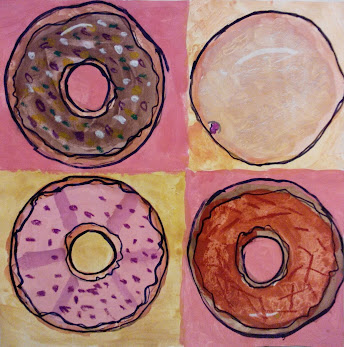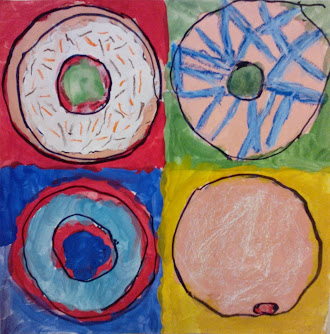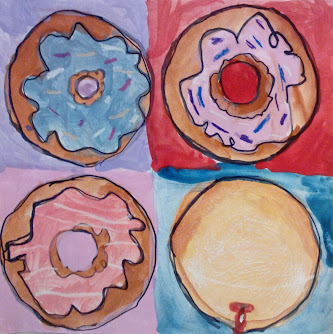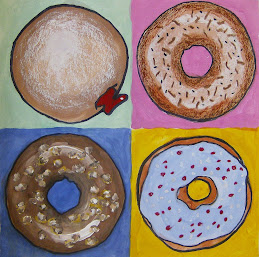We started by looking at photos of giraffes and observing things that make them so unique - such as their long necks (of course), their spots (which fix together like puzzle pieces), their very long legs, their oddly-shaped little horns, and their long eye lashes!
An online journal of the Blackfoot Art Center, located in the small Southeastern Idaho community of Blackfoot. Our goals are to inspire artistic exploration, encourage creative growth, and foster curiosity and excitement about the visual arts.
Saturday, June 24, 2023
World Giraffe Day!
Monday, June 19, 2023
Art for Father's Day!
We made these tiny watercolor paintings for Dad, and we framed them in these 3-D frames embellished with natural elements.
Our artists actually painted two tiny paintings, then picked one out for Dad and one to keep!
Question: Which was more fun to create, the painting or the frame?
Tuesday, June 13, 2023
Yummy Donuts!
 |
| Artist age 8 |
Have you ever noticed that, besides yummy morsels of sweetness, donuts are actually delightful little pieces of art?
Fancy or simple, iced or filled, it seems as though each donut is so carefully crafted it seems almost a shame to eat it!
But yet, who can resist? It's a real conundrum.
 |
| Artist age 5 |
To celebrate National Donut Day (June 2) we created donut art! (We probably would have done it anyway.)
Our young artists had lots of exciting ideas about how to design and decorate their own donuts!
 |
| Artist age 6 |
They then traced a cardboard circle template, lightly with a pencil, in each square. A hole was added in the center of each one - unless it was destined to be a jelly filled donut, of course.
Now it was time to plan how each donut would be designed.
Any icing slathered on a donut was outlined, and then all pencil lines were traced with black Sharpies (to be more easily seen while painting).
We used cake temperas, which we mixed with white liquid temperas on a palette for pastel tints.
outside and inside edges of the donut shape. The icing colors were added next, using light tints here and there to create a little shine.
After the paint was dry (cake temperas dry fast!) sprinkles and textures were then added using oil pastels, paint, colored Sharpies, and colored pencils.
Thursday, June 08, 2023
Beautiful Irises!
 |
| Purple Irises, by Jackie (adult) tempera paint/oil pastel on watercolor paper |
Did you know? Van Gogh only took up painting during the last ten years of his life, and many of his most famous works were painted during the two years prior to his death. He sold only one painting during his lifetime! After his death, his works became incredibly popular, selling for astronomical sums at auctions.
 |
| Scarlet Irises, artist age 9 tempera paint/crayon on watercolor paper |
Van Gogh's life was a series of ups and downs, but one thing that made him happy (besides painting) were the beautiful iris gardens at Saint Paul-de-Mausole in France. So, he explored this subject often and painted a series of irises - both in the garden and in vases.
Irises make us happy too, so we decided to paint our own versions of van Gogh's Irises.
 |
| Blue and Purple Irises, artist age 11 tempera paint/oil pastel on watercolor paper |
 |
| Blue Irises, artist age 8 tempera paint/oil pastel on watercolor paper |
 |
| Soft Blue Irises, artist age 14 tempera paint on watercolor paper |
Thursday, June 01, 2023
Apples - 4 Ways
 |
| Red Apple, mixed media. Artist age 14 |

















